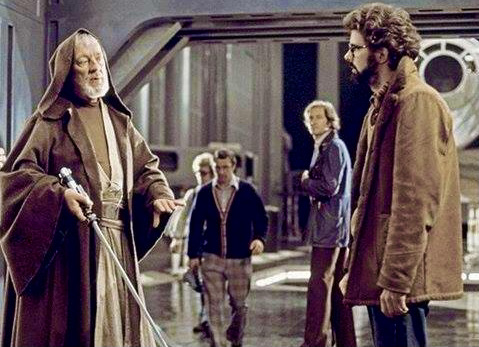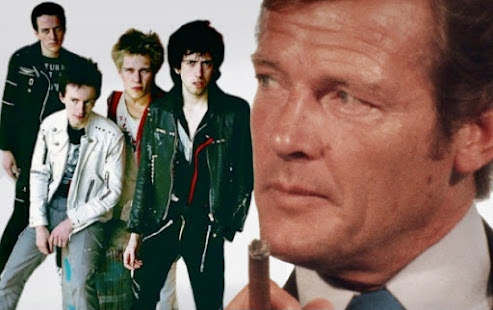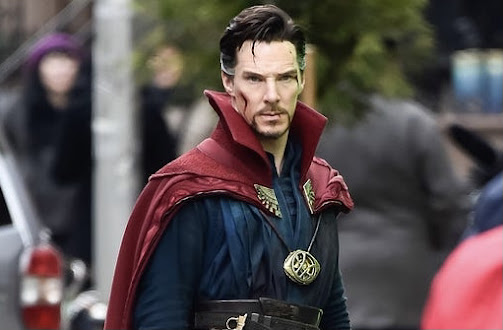On Friday, May 27, one of the most anticipated installments in one of the biggest franchises of all time dropped: Obi-Wan Kenobi, the new Disney+ mini-series. The six-part program features Ewan McGregor reprising his role as the titular Jedi Master, who he first portrayed in the STAR WARS prequel trilogy (1999-2005). McGregor’s Kenobi, was one of the most popular characters in the three widely disdained prequels, largely because his performance paid loving tribute to the actor that originated the role in the original STAR WARS trilogy.
That would be Sir Alec Guinness, who embodied Kenobi, Ben to his friends, in STAR WARS (1977, later re-titled A NEW HOPE), THE EMPIRE STRIKES BACK (1980), and RETURN OF THE JEDI (1980). So as McGregor again summons the wise, gentle spirit of Guinness for his new journey as Kenobi, let’s look back at an amusing factor that many fans are well aware of, but that many others may be blissfully unaware of – that is, Guinness’s heavy distaste for that “Galaxy far, far away.”
Hatred is a strong word, and Guinness never outright said he hated George Lucas’ iconic creation; just that it wasn’t really his cup of tea, and that its overwhelming popularity was a bit concerning. Since science fiction wasn’t his preferred genre (“Crumbs, not for me”), Guinness took the role for the money, and, with royalties from the 1977 film, and its sequels, he pocketed around $50 million, so we can definitely say that he didn’t hate the money.
Guinness had qualms at the beginning of the shoot of STAR WARS in Tunishia early 1976, noting in a letter to a friend that “new rubbish dialogue reaches me every other day on wadges of pink paper - and none of it makes my character clear or even bearable.”
In another letter, later in the shoot, Guinness wrote, “Apart from the money, I regret having embarked on the film. I like them well enough, but it's not an acting job, the dialogue - which is lamentable - keeps being changed and only slightly improved, and I find myself old and out of touch with the young.”
But when the film was released in the summer of ‘77, he was quite complimentary, writing in his diary: “It’s a pretty staggering film as spectacle and technically brilliant.”
At the height of the film’s success, Guinness appeared on the BBC talk show, Parkinson (hosted by Sir Michael Parkinson), where he praised STAR WAR’s “marvelous, healthy innocence. Great pace, wonderful to look at. Full of guts, nothing unpleasant – I mean, people go ‘bang bang’ and people fall over and are dead, but no horrors, no sleazy sex - in fact, actually, no sex at all, when it comes to that. And a sort of wonderful freshness about it, kind of like a wonderful fresh air. When I came out of the cinema at Tottenham Court Road, I thought to myself, ‘Oh Lord, London’s awfully gritty and dirty and full of rubbish, isn’t it’. Because it had all been so invigorating.”
But still, the script’s words were a sticking point as he told his diary, “some of the dialogue is excruciating and much of it is lost in noise.”
20 years later, Guinness was still going on about the dire dialogue in an interview in Talk magazine (1999): “What I didn't tell Lucas was that I just couldn't go on speaking those bloody awful, banal lines. I'd had enough of the mumbo jumbo.”
Throughout the years before his death in 2000, the grand actor went back and forth from thankfully acknowledging the fortune he received from the franchise (“Blessed be STAR WARS” he even said at one point), and lamenting that his involvement in the movie that earned him a Best Supporting Actor nomination was something that made him squirm.
Possibly Guinness’s best summation came in Alec Guinness: The Authorised Biography: “A refurbished STAR WARS is on somewhere or everywhere, I have no intention of revisiting any galaxy. I shrivel inside each time it is mentioned. Twenty years ago, when the film was first shown, it had a freshness, also a sense of moral good and fun. Then I began to be uneasy at the influence it might be having.”
Perhaps the most amusing episode in the saga of Guinness’s rocky relationship with STAR WARS comes in the form of an oft told tale about a young boy, who, when asking for an autograph from the original Kenobi, told him that he had seen the 1977 movie 100 times (actually 102 times). Guinness response was that he only give him the autograph, if the boy promised that he’d never see the film again.
This is how Guinness described the scene in his last memoir, A Positively Final Apperance (2000): “The bad penny first dropped in San Francisco when a sweet-faced boy of twelve told me proudly that he had seen Star Wars over a hundred times. His elegant mother nodded with approval. Looking into the boy’s eyes I thought I detected little star-shells of madness beginning to form and I guessed that one day they would explode.
“I would love you to do something for me,” I said. “Anything! Anything!” the boy said rapturously. “You won’t like what I’m going to ask you to do,” I said. “Anything, sir, anything!” “Well,” I said, “do you think you could promise never to see Star Wars again?”
Despite this anecdote being in Guinness’s book, I thought it was an exaggeration or amalgam of the man’s encounters with fans, but it’s been confirmed by the boy himself – Daniel Henning, an actor/audiobook narrator, who had, at 12 years old, met Guinness at an event in 1979. In 2019, Henning put out the audiobook, Alec Guinness Hated Star Wars or How I Became a Famous Star Wars Fan: A True Star Wars.
Henning says it went down like this: “I said, ‘Sir Alec, hello - I have seen STAR WARS 102 times,’ and I paused because I thought, when other people heard that they were kind of shocked and I thought that the audience might have some reaction too, which they did, there were gasps, there was laughter, there was a little bit of applause, and then Sir Alec literally did this in his chair (slumps back and acts dead)…and then he leans up to the microphone, and says, ‘it wasn’t even my best picture.’
Henning goes on, “And it would mean very much to me, if I could have your autograph.’ And I expected him to say, ‘Come down to the stage,’ and just sign it there. That was my fantasy of what was going to happen, that was how I was going to meet Alec Guinness, right? But instead, he said, he pointed his finger at me, and said ‘I’ll see you after the show.’”
After some joking around that I’ll edit for time, Henning explains, “We went backstage, my Mom and I, they immediately let us in, and everyone knew, like all the people backstage were like ‘there he is, there he is, there’s that boy.’ People were hanging around wanting to see whatever this is going to be, I guess. I didn’t quite realize that in the moment, but then when it happened, I was like ‘oh, they were all listening.’ We’re standing there and they bring Sir Alec over to me, and he was, huge smile on his face, and he was lovely, and charming, and the very first thing he said to me was, ‘I feel like I should give you some of my money back.’
Following even more kidding around banter, Henning arrives at the pivotal moment: “He says, ‘I’ll give you the autograph, but I want to ask you to do something for me.’ And I said, ‘anything.’ He said, ‘you’re not gonna like what I am going to ask you to do,’ and I said, ‘anything, anything!’ And he said, ‘Do you think you could manage never to see STAR WARS again?’ That is certainly not what I was expecting him to say. Again, I thought it was just going to be the moment of him signing the autograph, I didn’t realize we were going to get into his psychological issues with STAR WARS.”
The 12-year old Henning agreed that he would never again see the original movie again, and that Guinness even put it in writing (“you’ve promised me not to see STAR WARS again”) with his autograph on the program for the festival. Listen to the entire interview.
It’s interesting that Henning points out that Guinness’s first responses to the boy’s tally of viewings were about it not being his best work, and then the money thing. An art versus commerce predicament for the actor so succinctly displayed.
Whatever his issues with the supreme space opera, Guinness brought gravitas and a aged wisdom to the then budding franchise, despite only being 58 years old when he began his run as Kenobi. Having watched the first two episodes of Disney+’s Obi-Wan Kenobi series, I can attest that McGregor is successfully channeling Guinness, but at the same time putting forth his own rugged take on the character.
While the great Jedi Master Kenobi has grown in stature as a core character in the ginormous saga with the now extended portrayal by McGregor in the prequels, and the new series, I have a bad feeling that Guinness would still be shaking his head at the absurd longevity of the cult surrounding STAR WARS, and would be lamenting how the dialogue is still so lame.


















